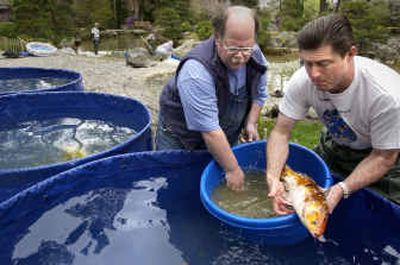Manito koi get the gift of cleanliness

If fish could talk, then the koi living in the Japanese Garden Pond in Manito Park would surely say “thank you.”
Not only did they get health check-ups and their own personal names Saturday, the 39 fish also got their watery home cleaned and scrubbed for the first time in eight years.
No one could have done it better than the people who love them the most – members of the Inland Empire Water Garden and Koi Society. This group of 40 koi aficionados, along with other volunteers, has embarked on one of the largest projects recently experienced by the residents of the Nishinomiya Japanese Garden Pond.
On Saturday morning, they herded the fish with nets and gently moved them into large holding tanks of water. Then they spent hours draining an estimated 125,000 gallons of murky, muddy water so they could shovel out gravel, pick up debris and scour away the thick, slick muck that caked the bottom of the pond.
“It was exciting to see the first piece of concrete,” said Cindy Noyes, surrounded by volunteers who were covered from head to toe with mud and slime. “It’s been an amazing thing.”
The project began last fall, when Manito Park supervisor Steve Gustafson approached the Inland Empire Water Garden and Koi Society. The nonprofit organization jumped at the chance to share their pond and koi expertise and organized the three-day cleanup, which began Friday and ended Sunday morning, when the fish were returned to their home.
While most of the volunteers emptied and cleaned the pond, others performed check-ups on the fish.
Hovering over the tanks, Claudia McGowen, president of the Koi Society, and Margie Luce, the local expert on koi health, placed each koi in a shallow tub and calmed it down with a liquid sedative. With tender touches, they examined each fish for scars, scissor cuts caused by herons and other injuries. Mary Bates, another Koi Society member, stood by taking careful notes – the fish’s gender, size and colors, irregularities and other information to help people recognize the fish in the future. Bates also wrote down the fish’s name, which was bestowed upon them by volunteers and park visitors who observed the cleanup.
By the end of the day, the koi had their own identities: Silver, a large, jumpy fish with yellow scales on its back; LC Tiger, a medium-sized orange and black koi, named by students from Lewis and Clark High School; and Saxonette, another sassy fish with a white body, a red head and silver, sparkly scales, which of course was named by the four volunteers from Ferris High School.
It’s hard to tell how old some of these fish are, said Koi Society member Anne Bronny, but several likely have been living at the pond since the Nishinomiya Japanese Garden was completed in 1974. While the fish vary in size and color, a few were nearly 2 feet long with an estimated weight of 14 to 15 pounds, she said. Most of the fish were deemed happy and healthy.
In order to keep them that way, water quality is absolutely essential, said McGowen. Over the years, a population of “uninvited guests” made up mostly of tiny goldfish called “rosy reds” has exploded because people have dumped them into the pond. These fish are detrimental to the koi, McGowen emphasized. They multiply quickly and contaminate the water with their waste. During the cleanup, the goldfish were taken out of the water and moved to the nearby duck pond. People also have tried to feed the koi – another no-no, according to McGowen, since they need special food that only park staff can provide.
“Just like any pet, fish are a responsibility,” said McGowen, who has 40 koi fish living in her ponds at home. She has a name for each one and can distinguish them by their size and appearance.
Each fish also has his or her own personality, said Steve Devaney, the group’s vice president. One of his 12 koi pets, for instance, is named Porky because he never misses a meal. Another is called Major because at 18 inches long, he’s definitely the boss of the pond.
“They’re family,” McGowen said.